RTR Assembly V2
RTR Assembly for V2 Routers (Square tube)
This step by step instructional video will walk you through the assembly of the Spark Robotic RTR Router kit
Router Assembly
-
1. Attach table legs (3 included - part # LG) together with table leg braces beams (4 included - part # LB) using the
5/16-18x7/8 Allen cap bolts.
*NOTE: Do not fully tighten bolts until the entire frame is together after step 4.
-
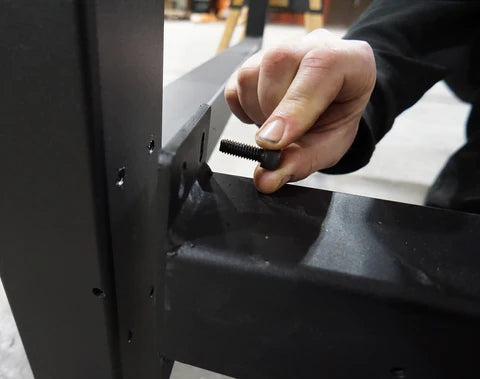
Step 1
-
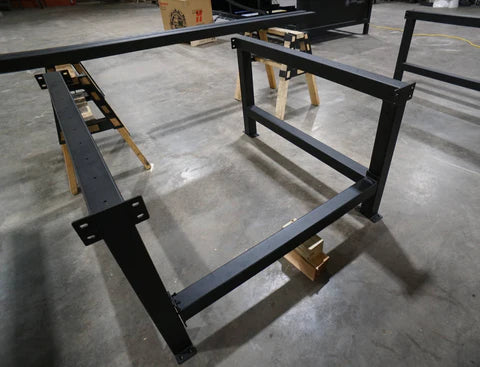
Step 1 continued
-
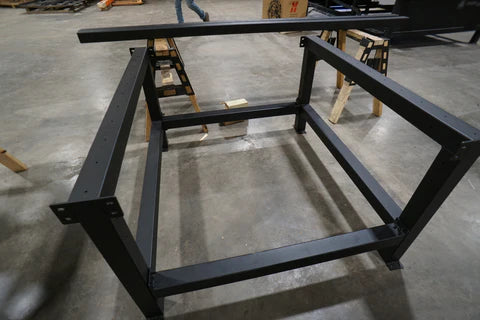
Step 1 continued
-
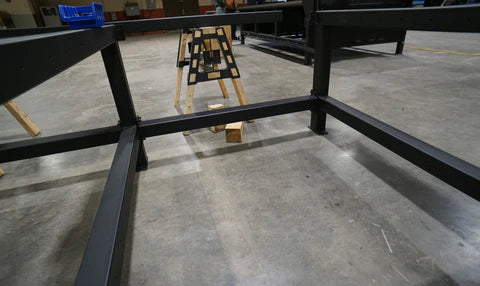
Step 1 continued
- 2. Attach table side extrusion beams (2 included - part # SEB) to table legs. Each side beam will be labeled with back right (BR), back left (BL), front right (FR), and front left (FL) to note which way they need to be attached.
3. Once all legs and the two side extrusion beams are loosely attached, install the side extrusion beam table top bars (2 included - part # TTB) with 5/16-18x7/8 Allen cap bolts. Continue on to Table Frame Squaring at this time before returning back to finalize the Table Frame Assembly.
-
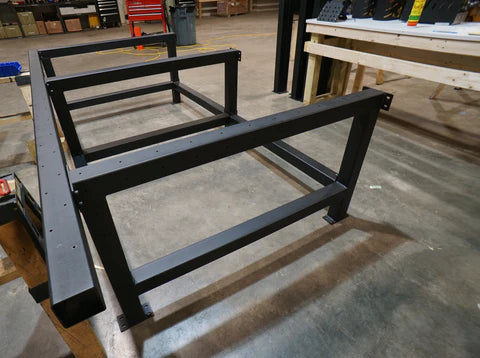
Step 2
-
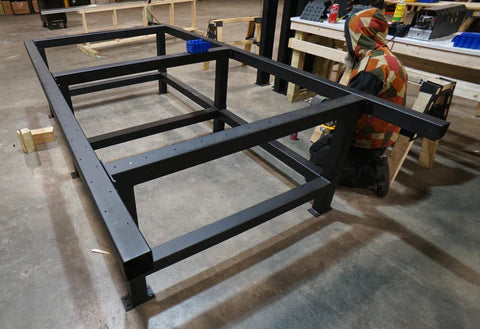
Step 2 continued
-
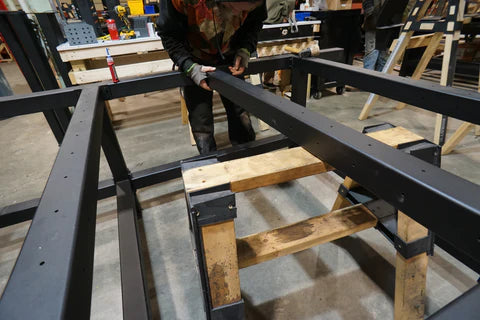
Step 3
-
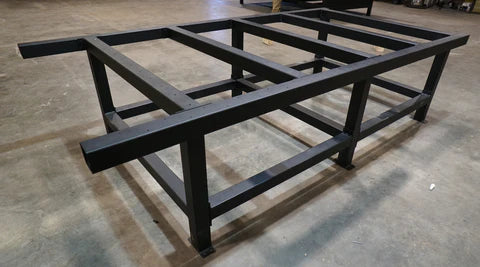
Step 3 continued
Table Frame Squaring
- *NOTE: This squaring procedure is to make sure the top face of the table frame is square.
A second squaring procedure will be explained after the gantry is installed.
-
1. Use a measuring tape to measure the parallel distance between the table side extrusion beams at both the front of the table and the back. The numbers should match.
2. Use the tape measure to measure the diagonal distance between the side extrusion beams from the right rear to the left front and from the left rear to the right front in an X pattern. The numbers should match.
*NOTE: If your measurements do not match: All the receiving flanges on all of the table frame parts have slotted holes to allow for some movement, this is to be able to finely adjust the table frame to make these squaring measurements match parallelly and diagonally.
-
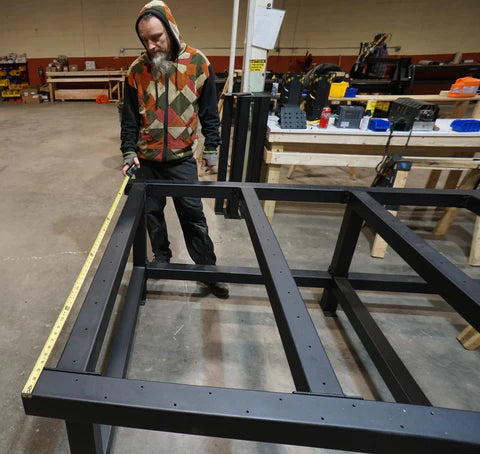
Step 1
-
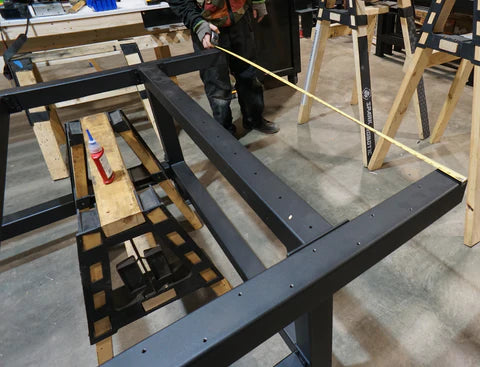
Step 1 continued
-
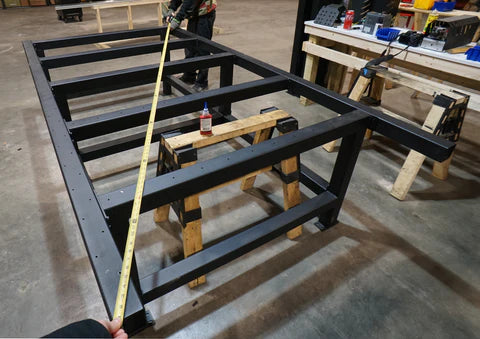
Step 2
-
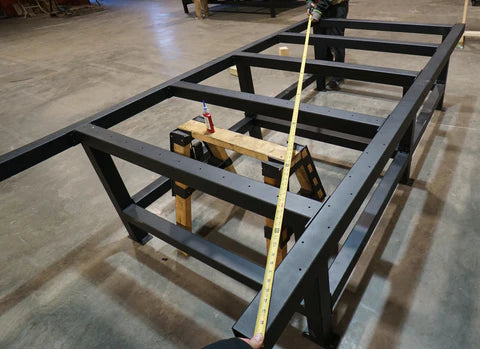
Step 2 continued
- *NOTE: Loctite is recommended on all table frame bolts to ensure the vibrations of running the CNC Router do not vibrate any of them loose.
-
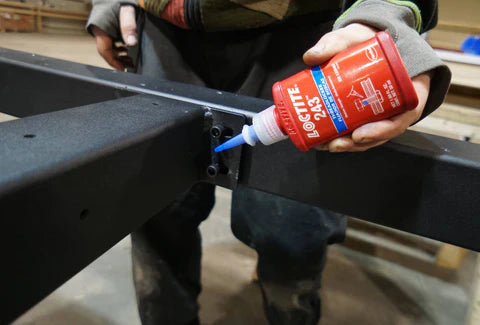
*Loctite is recommended on all table frame bolts
-
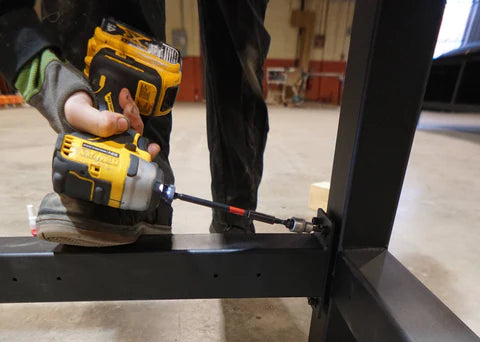
-
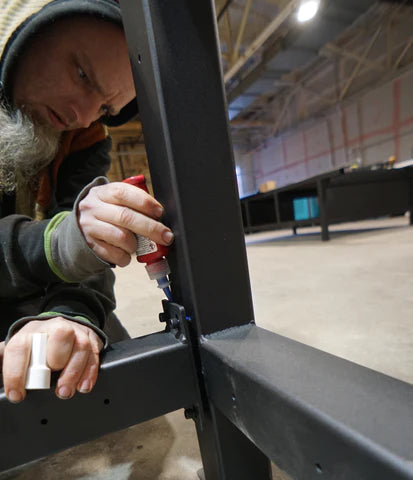
Router Assembly Continued
-
4.Now that the Table frame assembly is fully assembled, squared, and tightened: Mount the Table Board Brackets (5 included - Part # TBB) to the rear top of the legs assemblies and the table top bars using the provided self tapping M6 bolts.
-
*NOTE (1): Use clamps and something flat to insure that the top of the table board brackets mount flush to the top of the leg assemblies and table top bars. (see picture)
*NOTE (2): You will need to leave some of the bolts out of the front most table board bracket to mount the Control box / VFD mounting plate (see picture)
-
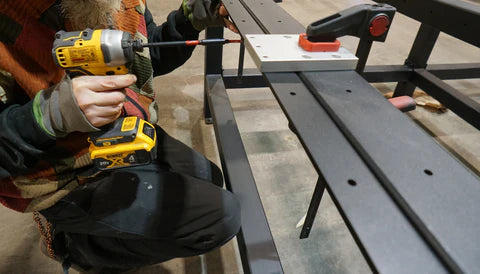
Step 4 (Note 1)
-
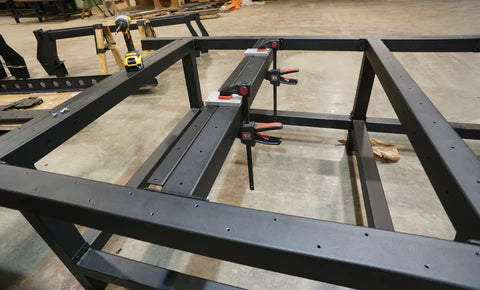
Step 4
-
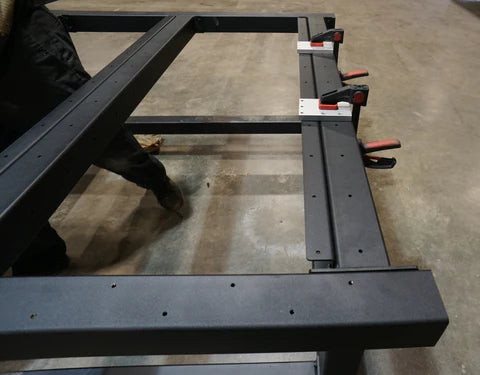
Step 4
-

Step 4 (Note 2)
-
5. At the front of the table, install the control box / VFD mounting plate to the back of the front leg (top and bottom) where you left out bolts from the front bracket in the previous step.
The bolts on the top will go: through the plate -> through the table board bracket -> into the leg back top
*NOTE: The round cutout in the control box / vfd mounting plate goes on the bottom
6. Install the linear rail extrusion assemblies (2 included - Part # LNR) to the top of the side extrusion beams using the supplied 1/4-20x5/8 button head bolts. DO NOT TIGHTEN THAM AT THIS POINT (finger tight). Linear rails are marked to match the side extrusion beams (BR,BL,FR,FL). Gear rack must be facing out.
-
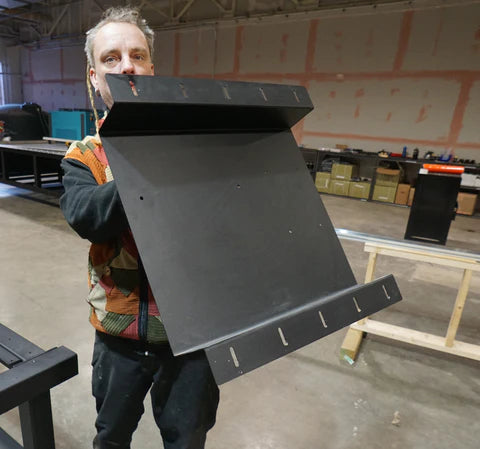
Step 5
-
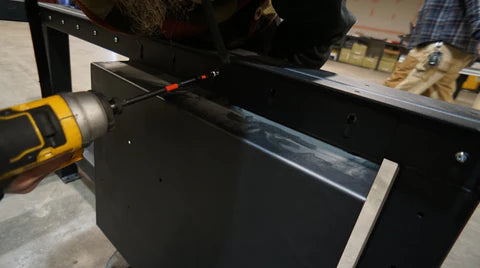
Step 5 continued
Gantry Prep
The gantry for the router is already fully assembled, however, there are a few things that must be done before installation.1. Remove both panels on the sides of the gantry to have access to the servo motors and sensors.
2. Attach the four bearing blocks to the gantry with the 16 (4 bolts per bearing) course M6-14 bolts. Make sure the grease zerks on the bearing blocks are facing inwards towards each other. DO NOT fully tighten the bearing block bolts, you will need some movement in the bearing blocks for gantry installation and then the bearing block bolts will be tightened in a later step.
*NOTE: Each bearing block has a black plastic ball retainer in the track. DO NOT remove the retainer until the gantry is installed.
Gantry Installation
-
**WARNING:
THE GANTRY IS A HEAVY LOAD. DO NOT ATEMPT TO LIFT OR INSTALL ALONE.**
1. Move the gantry to the back of the machine with the front of the gantry facing the front of the machine.
2. Installing the gantry can be done with two people but having one or two people hold it while one or two people align the bearings to the linear rail will make the process much easier. We have seen customers use fork lifts or gantry lifts to lift the gantry and align the bearings to the liner rail and slide the gantry on. Either way the goal here is to lift the gantry until the channel in the bearing blocks aligns with the linear rails attached to the underside of both of the side linear rail assemblies. they need to go on at the same time or the gantry will cock and not install smoothly. While sliding the gantry on, allow the linear rail to push out the black plastic bearing block retainers. WARNING: Pinch hazard: Use caution when removing the plastic bearing retainers.
*NOTE: Once the gantry is installed and all the bearing blocks are on the table frame, movement of the gantry might feel rough. If this occurs apply a little wd-40 or white lithium grease on the linear rails and gently glide the gantry back and forth to spread the lube and recheck for smoothness.
3. Now that the gantry is installed, attach the end caps (4 included - Part # END). each cap will be labeled individually (FR,FL,BR,BL) to not placement and are not interchangeable. Tighten all three 1/4-20x1/4 bolts on all 4 end caps.
Gantry Squaring
-
1. Pull gantry all the way to the front until it hits the end caps, the front most bearings should hit the end caps at the same time. If they do not hit at the same time or if there is any pivot / spring back on one side: Push the gantry toward the side that sprung back, this is why the 35 bolts on each of the linear top rail assemblies where left finger tight as the sloted holes in the linear assemblies will allow for some side to side movement to get the gantry square to the table frame.
2. Once the gantry evenly hits both front end caps and there is no spring back: tighten only the first button head bolt (the first of the 35 on both sides) on both side linear rail assemblies .
3. Push the gantry to the back of the table and repeat step two but in the rear of the machine except at this time do not tighten any of the 35 bolts in the top linear rail. Once the gantry slides evenly back and forth on the linear rails and the bearing blocks hit the end caps (left and right) at the same time in both the front and back of the machine with no spring back on either side: it is time to start checking and setting the squareness of the gantry.
4. Measure from inside to inside of the side plates on both the front and back of the machine. These measurements must match.
5. Note this exact measurement between the two side rails
6. Move the gantry to the back of the machine
7. Measure inside to inside on the top plates
-
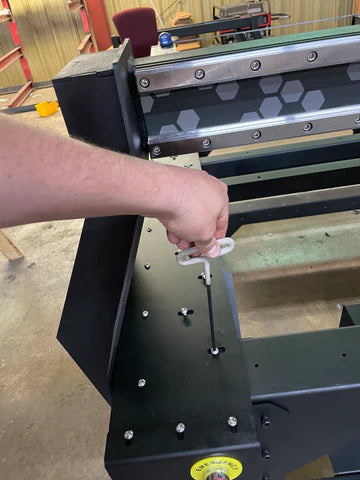
Step 2
-
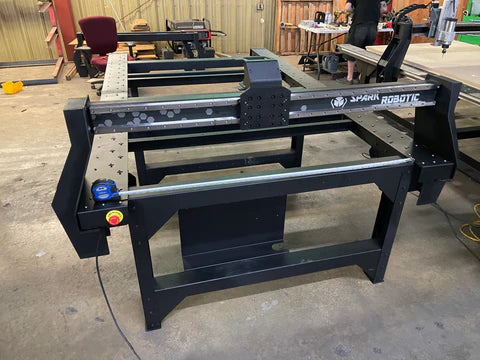
Step 4
-
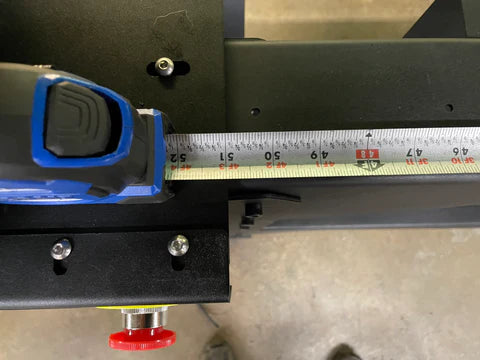
Step 5
-
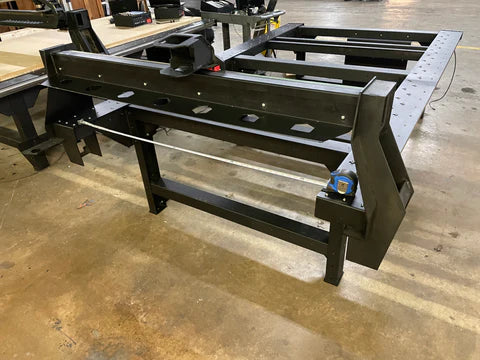
Steps 6 & 7
-
7. Adjust the top plates until the inside top inside measurement of the bamatches that of the front and tighten the first bolts
8. Tighten all the top plate bolts
-

Step 8
Router Assembly Continued
-
7. Install the side drag chain trays
- Pd001-1
- Pd002-1
- Pd003-400
- Pd004-400
- Pd005-400
- Pd070-1
- Pd072-400
- Pd073-100
- Pd143-4
- Pd144-3000
8.Install the wiring harness from the right side of the gantry along the right drag chain tray to the controller and VFD on the front of the machine
9. Connect the wiring harness to the controller and vfd, run the power cable to the controller box
10. Run the power to your VFD. The correct settings should be input already but if something is not working as designed regarding the VFD, check that the VFD is getting proper input first then verify these settings in the VFD
-
VFD settings


























